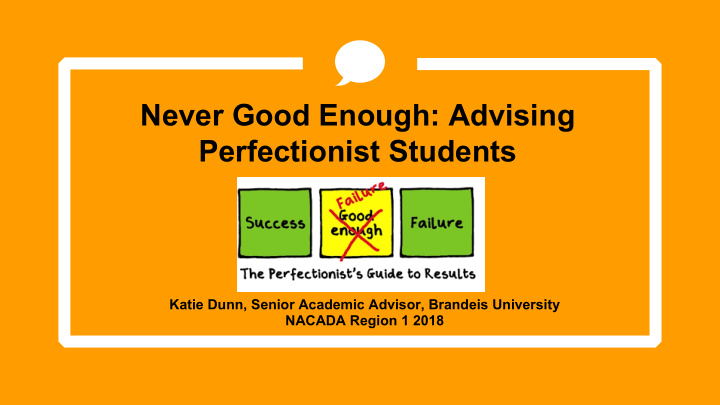



Never Good Enough: Advising Perfectionist Students Katie Dunn, Senior Academic Advisor, Brandeis University NACADA Region 1 2018
NACADA Region 1 2018 Think of a perfectionistic student you worked with recently … 1) What thoughts, feelings or behaviors did they exhibit? 2) How did their perfectionism impact their academics?
How do researchers define perfectionism?
NACADA Region 1 2018 Perfectionism is … • “The pursuit of extremely high performance expectations, or high personal standards.” (Slaney, Rice & Ashby, 2002)
NACADA Region 1 2018 Types of Perfectionism • Self-Oriented : Extremely high performance standards for themselves, drive for perfection comes from within • Socially Prescribed : Believe others hold extremely high performance standards for them, internalize these expectations
NACADA Region 1 2018 Interpreting Successes and Failures Self-Oriented Perfectionists: • Take personal pride in achievements, success is a result of their effort and hard work • Attribute failures to factors within and (sometimes) outside control • Still feel a great deal of frustration and anger after any sort of failure
NACADA Region 1 2018 Interpreting Successes and Failures Socially Prescribed Perfectionists: • Success is expected rather than something to be proud of; often attributed to external factors such as luck • Focus on failures, failures are attributed to internal factors, assume personal blame
Is perfectionism on the rise in young people?
NACADA Region 1 2018 Perfectionism & Young Adults • Perfectionism measured longitudinally in 41,000+ American, Canadian, and British college students (Curran & Hill, 2017) • Between 1989-2016, self-oriented perfectionism increased 10% and socially prescribed perfectionism increased 33% • Widespread social media use, a rise in meritocracy, specifically that a college degree is inevitable, given as possible theories.
In what ways does perfectionism negatively impact success and well-being?
NACADA Region 1 2018 Maladaptive Perfectionism • Characterized by discrepancy : “the perception that one consistently fails to meet the standards set for oneself.”(Slaney Rice, & Ashby, 2002) • Self-worth is contingent on meeting these excessively high standards • Very sensitive to criticism, highly concerned about making any mistakes • Goals are performance-focused
NACADA Region 1 2018 Maladaptive Perfectionism Maladaptive perfectionism associated with: • Increased depression • Increased anxiety • Difficulty regulating emotions • Drinking alcohol to cope • Low self esteem and self efficacy • “Mastery avoidance” • Procrastination
What are some environmental influences on perfectionism?
NACADA Region 1 2018 Family Influences Parenting Style: • Maladaptive perfectionists reported their parents adopted a more authoritarian parenting style • Self-oriented perfectionists reported their parents adopted a more authoritative parenting style
NACADA Region 1 2018 Family Influences Social Reaction Model: • Children may develop perfectionist tendencies as a way to cope with a harsh and/or chaotic family environment • Perfectionism seen as a way to escape, avoid shame, develop a sense of control.
NACADA Region 1 2018 Family Influences Helicopter Parenting : • A study of college students and their mothers by Schiffrin & Liss (2017) found children’s reports of maternal helicopter parenting were associated with maladaptive perfectionism Parent perfectionism: • Some studies have suggested children may develop perfectionistic tendencies of the same-sex parent through modeling behaviors
NACADA Region 1 2018 School Influences • Lack of challenge, continual success without experience of failure • “Stringent expectations” from teachers and peers • Peer groups built around ability, identity as “the smart kid,” positive feedback based on achievement • Doing well in school a way to please others, reinforce self-worth; doing poorly associated with disappointment, shame
Can perfectionism ever be good or helpful?
NACADA Region 1 2018 Adaptive Perfectionism or “Healthy Strivers” • Strive for excellence and mastery and gain pleasure from achievements but are able to cope with less than perfect • Tend to be orderly and conscientious • In most cases meet high standards they set • Shown to have high levels of: Ø Self esteem and self-efficacy Ø Interpersonal adjustment Ø Emotional regulation Ø Academic achievement (GPA)
NACADA Region 1 2018 University of Texas Counseling Center, 2014
How can we best work with perfectionist students?
NACADA Region 1 2018 Building Rapport • Listen empathically and take student seriously-this can be hard sometimes! • Affirm students’ strengths and validate concerns • Ask open ended questions from a place of curiosity and non-judgment • Avoid calling the student a “perfectionist” as that label may be perceived negatively
NACADA Region 1 2018 Additional Tools and Techniques • Ask gently challenging questions: Ø What do you mean by that statement? Ø What’s the worst that will happen? Ø How might you handle that? Ø How might you advise a friend in a similar situation? • Acknowledge a culture of perfectionism if it exists at your school and normalize less than perfect • Contextualize the long-term importance of the situation • Encourage “healthy striving” and achieving balance over perfectionism, introduce concept of self-compassion
NACADA Region 1 2018 Additional Tools and Techniques • Cognitive Restructuring/Reframing of Beliefs: Ø Notice “thought errors” and critique them Ø Where did this belief come from? Ø Is it objectively true? Ø What evidence do you have? Ø Is it helpful? Ø Is there another way to look at this? • Escape the avoidance/anxiety loop with “exposure.” Good enough is acceptable. • Use the policies of your school to help but not further hinder your student!
NACADA Region 1 2018 “Thought Error” Example
NACADA Region 1 2018 Anxiety/Avoidance Graph
Case Studies
Final Thoughts
NACADA Region 1 2018 Summary and Takeaways • Perfectionism is a multidimensional characteristic on the rise among today’s students • Perfectionism is influenced by deep rooted factors such as personality, family, school, peers, and culture • Perfectionism can lead to negative thoughts and behaviors which result in poorer mental health • “Healthy striving” is a useful alternative framework to counter perfectionism • Helping a student notice their perfectionism is an important first step
THANKS! Questions? Katie Dunn, Senior Academic Advisor, Brandeis University kdunn@brandeis.edu
Recommend
More recommend